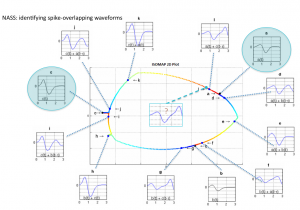-
26
Feb
Background noise and spike overlap pose problems in contemporary spike-sorting strategies. In this paper, both issues are addressed by a hybrid scheme that combines the robust representation of spike waveforms to facilitate the reliable identification of contributing neurons with efficient data learning to enable the precise decomposition of coactivations.
A recently introduced manifold learning technique, i.e. Isometric Feature Mapping (ISOMAP), reveals the intrinsic data structure, helps with recognising the involved neurons and, simultaneously, identifies the overlaps. Exemplar activation patterns are first estimated for all detected neurons and consecutively used to build a synthetic database in which spike overlaps are systematically varied and realistic noise is added.
An Extreme Learning Machine (ELM) is then trained with the ISOMAP representation of this database and learns to associate the synthesised waveforms with the corresponding source neurons. The trained ELM is finally applied to the actual overlaps from the experimental data and this completes the entire spike-sorting process.
The presented approach is better characterised as semi-supervised, noise-assisted strategy of an empirical nature. The user’s engagement is restricted at recognising the number of active neurons from low-dimensional point-diagrams and at deciding about the complexity of overlaps. Efficiency is inherited from the incorporation of well-established algorithms. Moreover, robustness is guaranteed by adaptation to the actual noise properties of a given data set.
This work has been published in Journal of Neuroscience Methods | 2010;190(1):129-42 and can be sited as:
Adamos DA, Laskaris NA, Kosmidis EK and Theophilidis G. NASS: an empirical approach to spike sorting with overlap resolution based on a hybrid noise-assisted methodology. Journal of Neuroscience Methods (2010);190(1):129-42 | doi: 10.1016/j.jneumeth.2010.04.018
- Published by Dimitrios A. Adamos in: Documentation
- RSS feed subscription!


 Neurobot via RSS
Neurobot via RSS
